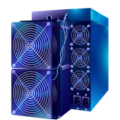Asic Miner Profitability
Our mining profitability calculator helps users quickly pinpoint the most lucrative mining options by delivering real-time data in multiple fiat and cryptocurrency currencies, including USD, EUR, GBP, AED, CAD, AUD, THB, ETH, and BTC. It allows precise electricity cost inputs up to three decimal places for highly accurate profit estimations. Users can access a clear overview of top-performing miners, algorithm-specific performance tables, and visually organized listings of mineable coins with recognizable cryptocurrency icons, simplifying decisions for maximum returns.
| Model | Hashrate |
Profitability
Profit
|
|---|---|---|
|
Goldshell XT-BOX
580GH/s
|
580 GH/s |
$6.14/day
|
|
Goldshell XT Card
100GH/s
|
100 GH/s |
$1.07/day
|
Our cutting-edge mining calculator offers comprehensive insights across all major cryptocurrency algorithms, helping users easily identify the most profitable options for their specific hardware. The algorithm data is continuously refreshed to keep pace with the dynamic crypto mining industry, providing accurate evaluations based on real-time profitability statistics and overall market activity. This empowers users to make well-informed choices that reflect the latest mining conditions and algorithm performance.
Bitcoin Mining Difficulty
Monitor the latest Bitcoin network difficulty metrics in real time, including block times & estimated time until the next difficulty adjustment.
Progress
Current progress:
61.51 %
Remaining Block
Blocks Left:
776
Remaining Time
Time Left:
~ 5 days 1 hours
Next Change
Upcoming change:
6.9 %
Block Time
Current Block Time:
9.4 minutes
What is SHA3x algorithm?
Why Should You Rely on Our Profit Calculator for Accurate Mining Insights?
On Tari, security advances with the steady pulse of hashes, where routine computation quietly yields a durable miracle of consensus and time. The engine is SHA3x, a proof-of-work algorithm derived from the SHA-3 family and adapted to open participation. It relies on the Keccak sponge construction, which is noted for strong preimage and collision resistance. Miners vary nonces and mix block data until the digest falls below a target that encodes current difficulty. Difficulty adjusts to keep block cadence stable as participation changes. SHA3x favors parallelism on modern GPUs from NVIDIA and AMD, so widely available hardware can reach competitive throughput. Tari pairs this with simultaneous mining via Monero’s RandomX, which invites CPUs to contribute while producing Monero blocks in the same cycle. The result is dual-mining that improves hardware utilization and spreads hashpower across architectures. This blend accommodates GPU rigs, general-purpose CPUs, and even prospective ASICs without granting any single class easy dominance. By diversifying participants, the system reduces centralization risk, smooths variance for miners, and hardens the network against targeted attacks. The protocol orders transactions, validates blocks, and enforces rules with probabilistic finality that strengthens as confirmations accumulate. Fees and block rewards motivate honest work, while the hybrid design lowers entry barriers for newcomers who can begin with equipment they already own. In practice, SHA3x is both a path to earn XTM and the daily ritual that keeps throughput scalable, latency predictable, and integrity intact.
Latest ASIC Miners
Check out the latest ASIC miners added to our site. These are the newest listings, featuring the most recent models.
V3
Nerdminer
AE3
IceRiver
Antminer L11 Hyd 2U
Bitmain
Why ASIC Mining?
The Advantages of ASIC Mining Compared to Other Mining Types
ASIC (Application-Specific Integrated Circuit) mining involves specialized hardware designed exclusively for mining cryptocurrencies like Bitcoin, offering unmatched efficiency and performance. Unlike general-purpose GPUs, ASICs are optimized for specific algorithms, delivering significantly higher hashrates while consuming less power per hash. This makes them far superior for mining tasks, as they maximize profitability by reducing electricity costs and increasing mining output. ASIC miners are purpose-built, providing stability and reliability in high-demand mining environments, unlike GPUs which are prone to overheating and wear during prolonged use. Their compact design also allows for easier scalability in large mining operations. By focusing solely on mining, ASICs eliminate the overhead of multi-purpose computing, resulting in faster block-solving times. This efficiency translates to higher rewards, making ASICs the preferred choice for serious miners aiming to stay competitive in the cryptocurrency market. In contrast, GPU mining, while versatile, cannot match the raw power and cost-effectiveness of ASICs for dedicated mining tasks.
Optimized for Mining
Energy Efficient
Reliable & Stable
Scalable
More about the SHA3x algorithm
See how our profit calculator delivers accurate, real-time mining insights, helping miners make informed decisions.
Tari (XTM) is the native utility token that anchors the MinoTari Layer 1 blockchain and powers the broader Tari network, built with unflinching focus on digital assets-NFTs, in‑game items, ticketing, and loyalty programs-where clear rules, privacy, and composability matter more than spectacle; its dual‑layer architecture separates hard settlement from high‑throughput logic so the system scales without surrendering security or user control: Layer 1 (MinoTari) employs a hybrid proof‑of‑work that combines standalone SHA3x with RandomX merge‑mining alongside Monero, allowing miners to secure Tari and Monero simultaneously from the same work, which deepens security, diversifies hashpower, and optimizes hardware utilization by welcoming both CPU miners via the ASIC‑resistant RandomX design and more specialized SHA3x setups, all while reducing the risk of single‑hardware capture; miners are incentivized in XTM to validate transactions and maintain final settlement on L1, whereas the Tari Digital Assets Network (DAN) on Layer 2 handles the heavy lift-rapid issuance, trading, transfers, programmable rules, and asset lifecycle management-then commits results back to L1 for finality and dispute resolution, keeping fees predictable and latencies low for application workflows; the protocol’s dual‑token model links the layers economically by burning XTM on L1 to mint XTR, the L2 utility token, establishing a soft peg and a structural sink that can make XTM deflationary as L2 activity grows, aligning incentives between security providers and application builders; privacy is first‑class, with confidential transaction features that shield asset amounts and ownership details while preserving verifiability, a necessary guardrail for tickets, loyalty points, and game items where fair transfer, anti‑fraud, and user sovereignty must coexist; beyond security and scale, this design unlocks practical advantages-merge‑mining leverages existing Monero miners to harden Tari from day one, DAN’s batched and parallel execution reduces congestion for asset‑heavy use cases, and the separation of concerns lets builders ship asset‑centric logic without burdening the base layer-producing a network that treats digital property not as hype but as disciplined, programmable rights underpinned by neutral settlement, inclusive mining, and resilient economics.
 English
English
 German
German
 Hungarian
Hungarian
 Dutch
Dutch
 Spanish
Spanish
 French
French
 Italian
Italian
 Czech
Czech
 Polish
Polish
 Greek
Greek



















